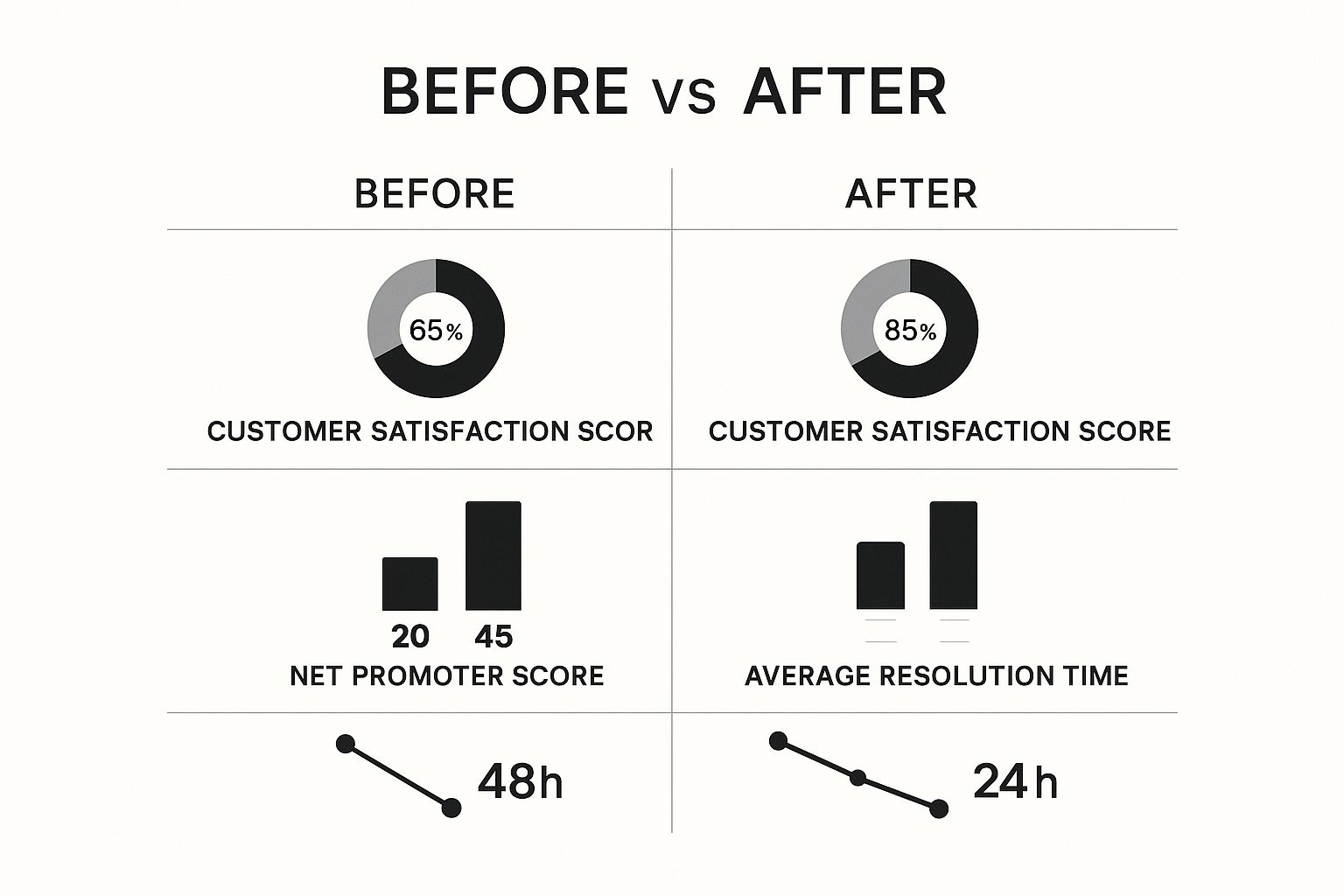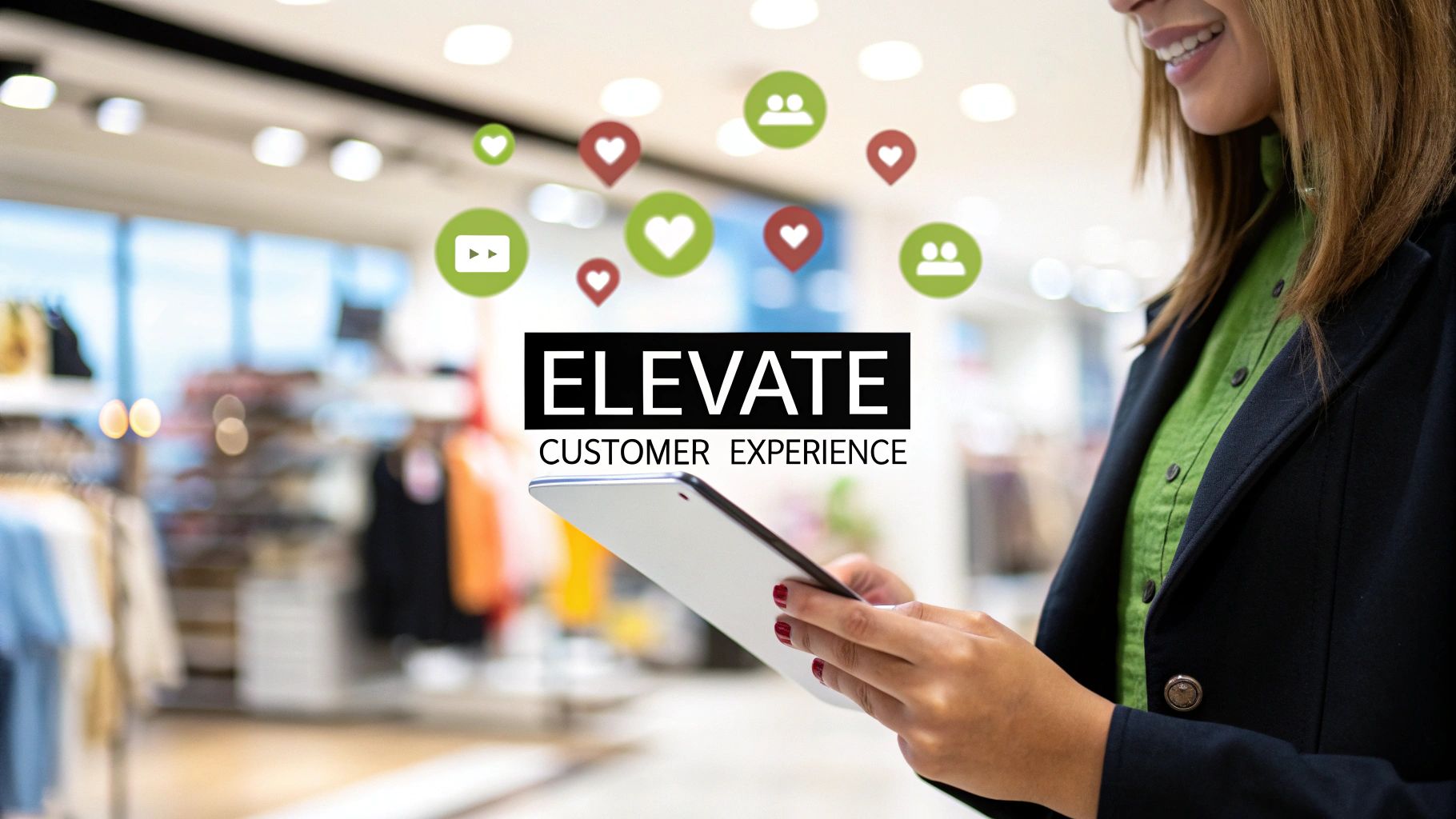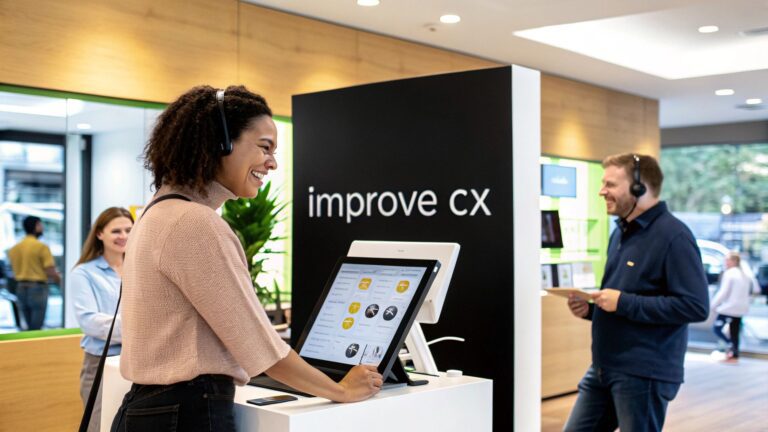If you really want to improve your customer experience, you have to start with one simple, fundamental truth: you need to see your business through your customers' eyes. It’s all about tracing their entire journey, from the very first time they hear your name to the moment a product lands on their doorstep. This process isn't just an exercise; it's about uncovering the moments that make them smile and the ones that make them want to tear their hair out.
Understanding Your UK Customer Journey

Before you can fix anything, you have to live the experience. I’m not talking about theory here; I mean literally walking in your customers' shoes. The aim is to create a visual map of their entire journey. This gives your team a shared, crystal-clear picture of the moments that matter most and, crucially, where the biggest opportunities for improvement are hiding. It’s a powerful tool—companies that really dig into this see 4-8% higher revenue growth than those who don't.
Mapping Every Interaction Point
Let's get practical. The first step is to list every single touchpoint a customer could possibly have with your business. Think bigger than just your website or your shop. A truly comprehensive journey map covers everything, from the initial spark of awareness to the long-term relationship.
I find it helps to break the journey down into key stages:
- Awareness: How do people find you in the first place? Is it a Facebook ad they scrolled past, a recommendation from a mate, or a search on Google?
- Consideration: What happens when they’re weighing their options? Maybe they're flicking through your website, reading online reviews, or having a chat with one of your sales reps.
- Purchase: How smooth is the actual transaction? Is your checkout process a breeze, or are there unexpected delivery fees that pop up at the last second?
- Post-Purchase: This phase is so often overlooked. It covers everything from the order confirmation email and delivery updates to the actual unboxing experience and any follow-up support they might need.
By detailing these stages, you build a complete picture of the customer lifecycle. You’d be amazed at what you uncover. I've seen beautifully designed e-commerce sites completely let down by a confusing order confirmation email that leaves customers in the dark.
"You’ve got to start with the customer experience and work back toward the technology—not the other way around. Mapping the journey ensures your efforts are always aligned with customer needs, not just internal processes."
Gathering Honest Feedback
Of course, a map is just a pretty diagram without real data. To bring it to life, you need honest, unfiltered feedback. This is how you move from what you think is happening to what is actually happening.
One of the most effective ways to get this is with simple, well-timed surveys. Forget long, boring annual questionnaires. Instead, send short, contextual surveys right after a key interaction. For instance, you could trigger a one-question pop-up—"How easy was it to find what you were looking for today?"—just after someone uses your website’s search bar.
And don't forget the power of just talking to people. A quick phone call to a few recent customers, both the happy ones and the unhappy ones, can offer more genuine insight than a thousand survey responses. Ask open-ended questions like, "Could you walk me through why you chose us?" or "Was there any part of the process you found frustrating?" These conversations capture the little details that raw data always misses, giving you a goldmine of information on where you’re winning and where you're falling short.
Building a Seamless Omnichannel Experience
Your customers don't live in a single channel, so why should your support? People in the UK today flip between WhatsApp, email, social media, and your website's live chat without a second thought. They naturally expect your business to follow the conversation. Nothing sours a customer relationship faster than having to repeat the same problem to three different people.
To get this right, you need to think of customer service not as a series of separate tickets, but as one long, continuous conversation. It doesn't matter if it starts on Instagram and ends in an email a week later; the context has to travel with it. The goal is to make the entire experience feel connected and intelligent.
Unifying Your Communication Channels
The real magic happens when you integrate all your support channels so they can actually talk to each other. Stop thinking of your Instagram DMs, support emails, and website chat as different queues waiting for an answer. Instead, pull them all into a single, unified view. This is the only way to give your team the full backstory on every customer interaction.
Here's a classic example: a customer pings you on your website's live chat with a quick question about a product. A few hours later, they follow up with more detail via email from their phone. In a disconnected setup, two different agents would likely handle these messages, completely blind to the other's existence. An omnichannel system, on the other hand, means the second agent instantly sees the original chat transcript. They can pick up right where the conversation left off, without asking the customer to explain everything all over again.
This isn't just a "nice-to-have" feature anymore; it's a core expectation. Recent research found that 67% of UK shoppers expect a reply to their enquiries within just two hours. The same study revealed that British consumers now demand this kind of seamless journey, whether they're messaging on WhatsApp or commenting on a social post. And here’s the kicker: retailers who adopted integrated service platforms saw 40% fewer complaints about communication gaps. You can discover more insights on the latest UK customer service trends to stay ahead of the curve.
Key Omnichannel Integration Points
So, where do you start? To build this kind of joined-up experience, it helps to focus on a few critical integration points that deliver the biggest impact for both your customers and your team.
Below is a quick breakdown of the areas that truly matter when you're aiming for a unified support system.
| Integration Point | Customer Benefit | Business Action Required |
|---|---|---|
| Unified Customer Profile | Customers don't have to repeat their order history or past issues, making interactions faster and less frustrating. | Implement a CRM or helpdesk that consolidates all interactions from every channel into a single customer timeline. |
| Cross-Channel Context | A conversation can start on live chat and seamlessly move to a phone call without losing any information or context. | Choose support tools that offer cross-channel continuity, allowing agents to see the full history regardless of the platform. |
| Consistent Brand Voice | The tone and quality of support remain consistent, whether the customer is on Twitter or speaking to an agent. | Develop clear brand voice guidelines and train all customer-facing staff to apply them across every communication channel. |
Getting these pieces right is what transforms your support from a series of isolated interactions into a single, coherent conversation.
A truly omnichannel experience isn't about being everywhere; it's about being consistent and connected everywhere you are. It ensures the customer feels like they are having one single conversation with your brand, not a dozen separate ones.
By unifying your support systems, you're doing more than just making customers happier. You're also making your team far more efficient. Agents can stop wasting time hunting for information and focus on what they do best: solving problems. This shift is absolutely fundamental to succeeding in modern e-commerce.
Using Personalisation to Build Loyalty

Let's be honest, the days of one-size-fits-all customer service are long gone. Today's customers don't just hope you know who they are—they expect it. They want you to understand their needs, sometimes even before they do. This is where smart personalisation comes into its own, transforming a standard transaction into a memorable interaction that builds real trust.
True personalisation goes far beyond just dropping a customer's first name into an email template. It’s about using the data you have, both ethically and intelligently, to make every single touchpoint feel genuinely relevant and helpful.
And the impact? It’s massive. Studies show that 49% of buyers have made an impulse purchase simply because they received a more personalised experience. This is a clear shift from just solving problems to proactively anticipating needs. Think about it: it’s the difference between waiting for a customer to complain about a missing delivery and sending them an alert about a potential delay before they've even had a chance to worry.
Making Personalisation Practical
To genuinely elevate the customer experience, you need to weave personalisation into the very fabric of your service. This isn't some complex strategy reserved for massive corporations, either. Even small businesses can make a huge impact with the right focus and tools.
For example, something as fundamental as effective local SEO for a small business is a form of personalisation, connecting your services directly to a customer’s immediate, location-based needs.
Here are a few actionable ways to get started:
- Tailored Product Recommendations: Ditch the generic "bestsellers" list. Instead, tap into a customer's purchase history to suggest items that actually make sense for them. If someone just bought a high-end coffee machine from you, a follow-up email with recommendations for speciality beans or cleaning kits feels helpful, not pushy.
- Proactive Support: Don't wait for the help ticket to come in. If a customer buys a product that requires a bit of setup, send them a helpful guide or a short tutorial video a day or two later. It shows you’re invested in their success long after the payment has cleared.
- Segmented Communication: Group your customers based on their behaviour. You could create segments for first-time buyers, loyal repeat customers, and even those who haven't purchased in a while. Each group can then receive different messages and offers that are far more relevant to their relationship with you.
A customer who feels understood is a customer who stays. Personalisation isn’t about invading privacy; it’s about providing value by demonstrating that you’ve been paying attention to their individual journey with your brand.
Using Data to Drive Deeper Connections
The bedrock of any great personalisation strategy is data. Every single interaction—from a click on your website to a query sent to your support team—is a clue. These clues reveal a customer's preferences, their challenges, and what they value. By carefully collecting and analysing this information, you can start building a much clearer picture of who they are.
Imagine a customer who often browses your vegan-friendly product category but has never actually bought anything. A smart personalisation engine would see this pattern and could trigger a targeted offer on those specific items. Or perhaps it might send an email highlighting your brand's commitment to sustainable sourcing.
This kind of detail shows customers you see them as an individual with unique interests, not just as another order number. It's a powerful approach that makes people feel truly valued and is one of the most effective ways to build lasting loyalty.
Empowering Your Team for Exceptional Service
At the end of the day, your customer experience is only as good as the people delivering it. It's a simple truth. If your team feels unsupported or disengaged, they're just not equipped to create happy, loyal customers. The single most effective way to elevate your service is to invest directly in your front-line staff—moving them beyond product knowledge and into building genuine human connections.
Great service isn't about reciting a script. It’s about arming your team with the soft skills that turn a routine transaction into a memorable interaction, the kind that makes a customer feel genuinely valued.
Beyond Scripts to Real Skills
The focus has to shift towards abilities that make customers feel truly heard. Active listening, for example, isn't just about hearing the words; it's about catching the frustration, confusion, or urgency behind them. Empathy is what allows your team to connect on a personal level, turning a potentially negative situation into a chance to build an even stronger relationship.
Think about developing these core skills:
- Active Listening: Train your people to listen for the real problem, not just the complaint on the surface.
- Problem-Solving Authority: Give them the power to offer a discount, process a refund, or find a creative fix without needing to "speak to a manager".
- De-escalation Techniques: Equip them with practical strategies to calmly manage frustrated customers and turn a bad experience into a good one.
The most powerful tool you can give your team is trust. When employees feel trusted to make decisions, they take ownership of the customer's problem. That's when they're truly motivated to find the best possible solution right there and then.
The Power of Getting It Right First Time
This kind of empowerment has a massive impact on both your efficiency and customer happiness. The latest UK Customer Satisfaction Index makes it crystal clear: there's a direct link between resolving an issue on the first try and higher satisfaction scores. When your team can solve problems independently, they slash customer effort and stop small hiccups from turning into major headaches. The full research from The Institute of Customer Service really drives home how crucial "right first time" service has become.
A well-supported team is, without a doubt, your greatest asset. Investing in their skills and autonomy pays for itself time and time again through customer loyalty and positive word-of-mouth.
For larger operations, it can also be worth exploring the benefits of UK customer care outsourcing to scale your support. And don't forget the digital side of things—our guide on website usability testing will help ensure your online experience is just as welcoming.
Winning with the In-Store Experience

For any UK business with a physical location, the shop floor is where customer loyalty is truly won or lost. In a world dominated by online shopping, the tangible experience a customer has inside your four walls can become your single most powerful advantage.
It all boils down to getting the fundamentals spot on. Details that might seem small—spotless premises, a logical store layout, and well-managed queues—actually have a massive impact on how a customer feels. These elements show you respect their time and attention, making them feel valued from the second they walk through the door.
The stakes for physical retail in the UK have never been higher. A poor in-store experience is a huge driver of lost revenue. In fact, research shows a staggering 80% of UK adults have walked away from a purchase because of long queues, no staff to help, or a messy environment. It’s clear: well-organised stores with prompt service directly boost both sales and loyalty.
Crafting an Inviting Environment
A brilliant in-store atmosphere engages all the senses and is planned down to the last detail. It's not just about what customers see, but what they feel, hear, and even smell. To really get this right, following essential visual merchandising guidelines is crucial for pulling shoppers in and keeping them engaged.
Think about these practical points:
- Clear Navigation: Are your aisles wide enough to navigate comfortably? Is the signage easy to read and genuinely helpful? A customer should be able to find what they’re looking for without a hint of frustration.
- Atmospheric Control: Pay attention to the lighting, temperature, and even the scent of your shop. A warm, welcoming environment naturally encourages people to stick around and explore what you have to offer.
- Staff Presence: Your team should be visible and approachable, not just hiding behind a till. A friendly face can instantly turn a moment of indecision into a positive, helpful interaction.
Your physical store is more than just a point of sale; it's a brand embassy. Every single detail, from how clean the floors are to how helpful your staff are, communicates your brand’s values and its commitment to the customer.
Blending Digital with Physical
The modern in-store journey shouldn't exist in a vacuum, separate from the digital world. Smartly integrating technology can solve common frustrations and create a much smoother, more enjoyable visit.
Consider bringing in mobile payment systems to cut down on queues, or placing tablets around the store to create an "endless aisle." This lets customers order out-of-stock items for home delivery right there and then. This blend of the physical and digital creates a seamless experience that makes people want to come back.
Measuring What Matters for Continuous Growth
You've heard the old saying: you can't improve what you don't measure. Nowhere is this truer than in customer experience. It’s not a "set it and forget it" project, but a constant cycle of listening, adapting, and fine-tuning. To make real, lasting progress, you have to anchor your efforts in solid data.
This means getting away from hunches and focusing on specific metrics that reveal how customers really feel about their journey with your brand. These key performance indicators (KPIs) become your North Star, guiding your strategy and showing you exactly where your hard work is paying off.
Key Metrics to Guide Your Strategy
So, which numbers actually matter? While there are dozens you could track, three core metrics give you a surprisingly complete picture of customer sentiment.
-
Net Promoter Score (NPS): This one is all about long-term loyalty. It’s based on a single, powerful question: "How likely are you to recommend us to a friend or colleague?" The answers sort your customers into Promoters, Passives, and Detractors, giving you a single score that acts as a fantastic health check for your brand.
-
Customer Satisfaction (CSAT): Think of CSAT as an in-the-moment happiness snapshot. It's usually asked right after a specific interaction—like a support chat or a purchase—to gauge immediate satisfaction. This makes it brilliant for finding and fixing friction points in specific parts of the customer journey.
-
Customer Effort Score (CES): This metric gets right to the heart of a modern customer expectation: ease. CES asks how easy it was for a customer to get their problem solved or their question answered. A low-effort experience is one of the strongest predictors of loyalty, making this an essential metric for streamlining your processes.
This is a lot to take in, so here’s a simple table to break down how these three crucial metrics compare.
Customer Experience Metrics Compared
| Metric | Focus | Key Question Answered |
|---|---|---|
| Net Promoter Score (NPS) | Overall loyalty and brand perception | "Would you recommend us?" |
| Customer Satisfaction (CSAT) | Immediate, transactional happiness | "Were you happy with that specific interaction?" |
| Customer Effort Score (CES) | Ease of a specific interaction or process | "How easy was it to get what you needed?" |
Each metric tells a different part of the story. Using them together gives you a much richer understanding than any single one could on its own.
The impact of focusing on these metrics isn't just theoretical. Look at the difference it can make when a business truly commits to a customer-centric strategy.

The numbers speak for themselves. A focused CX strategy can drive huge gains in satisfaction and loyalty while slashing the time it takes to resolve issues.
A great customer experience strategy never becomes outdated because it's built on a foundation of continuous feedback. Use these metrics not just to report on the past, but to actively shape a better future for your customers.
Got Questions? We’ve Got Answers
When it comes to improving customer experience, it's natural for a few common questions to pop up. We see the same queries from businesses all the time, so we’ve put together some straightforward answers to help clear things up.
What’s the One Thing That Truly Makes for a Great CX?
If you had to boil it all down to one thing, it would be reducing customer effort. Think about it – we're all busy, and we value simplicity more than ever.
When you make it incredibly easy for someone to get an answer, fix an issue, or buy from you, you’re already miles ahead. In fact, focusing on an effortless experience is one of the biggest drivers of customer loyalty.
A seamless, low-effort experience tells your customers you respect their time. That simple respect builds far more trust and loyalty than any big, flashy gesture ever will.
How Can Smaller Businesses Compete When Budgets are Tight?
You don't need a massive budget; you just need to be smart and focused. The key is to lean into the things that bigger companies often let slide.
- Get personal: A simple thing like using a customer's name in an email or remembering a previous chat makes a huge difference.
- Communicate proactively: Drop a quick text to confirm an appointment or give a heads-up about a slight delay. It shows you’re on top of things.
- Empower your team: Let your staff solve small problems on the spot. Giving them the power to issue a £5 refund without needing a manager’s sign-off is liberating for them and impressive for the customer.
These little human touches cost next to nothing but make people feel properly looked after.
How Long Does It Take to See Real Results from CX Improvements?
You might be surprised at how quickly you can see a change. Building deep, lasting loyalty is a long game, of course, but you can get positive feedback almost immediately from small tweaks.
For instance, rewriting your email auto-responder to be more human and genuinely helpful can lift customer sentiment in a single day.
You'll likely spot these small wins within weeks. For the bigger-picture metrics, like customer retention rates and a noticeable impact on revenue, give it about three to six months to see the trends emerge clearly.
Ready to turn your website into an experience your customers will rave about? The experts at Ibertech Solutions Limited specialise in creating bespoke websites and digital strategies that build loyalty and drive growth. Explore our web design and IT solutions today.





